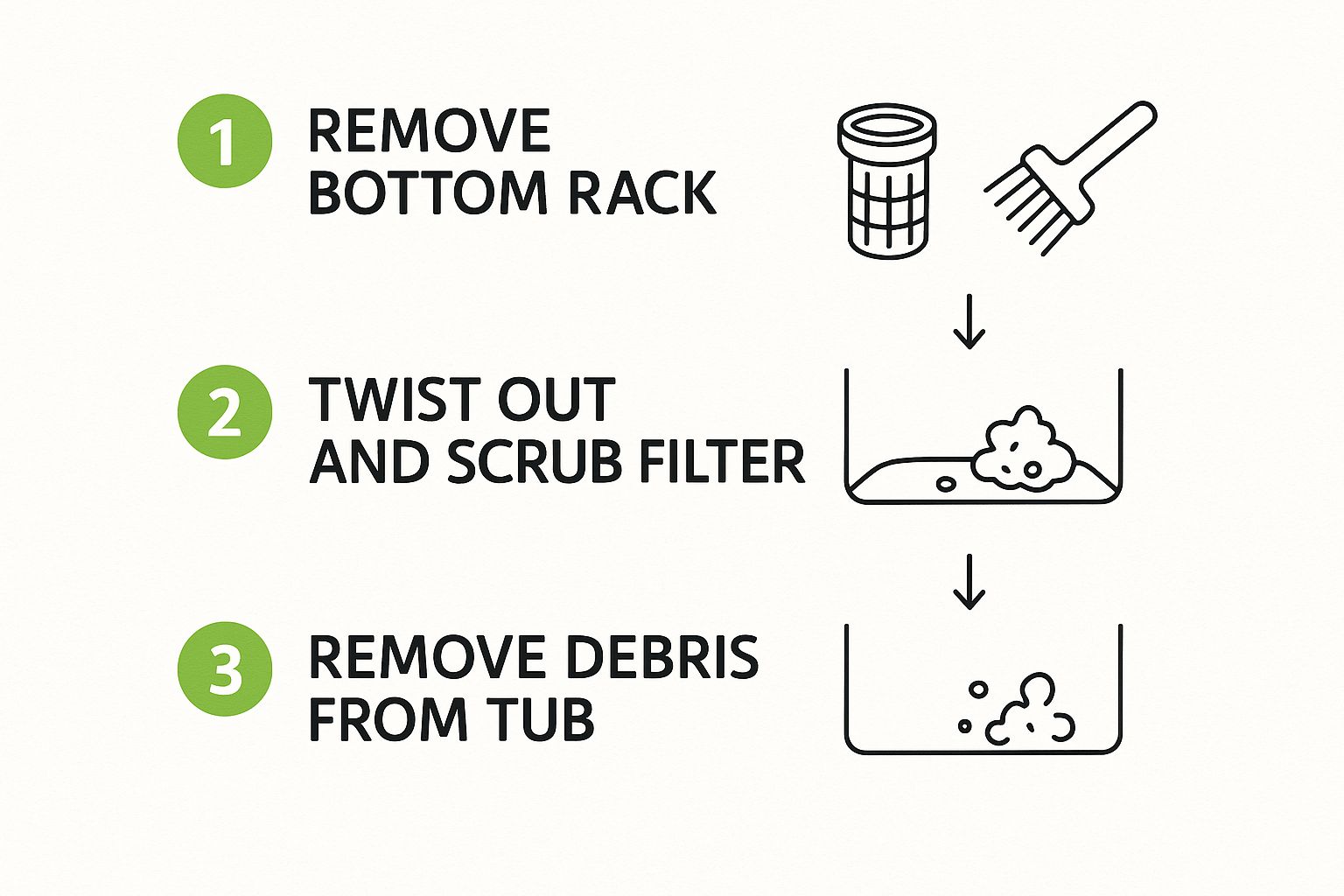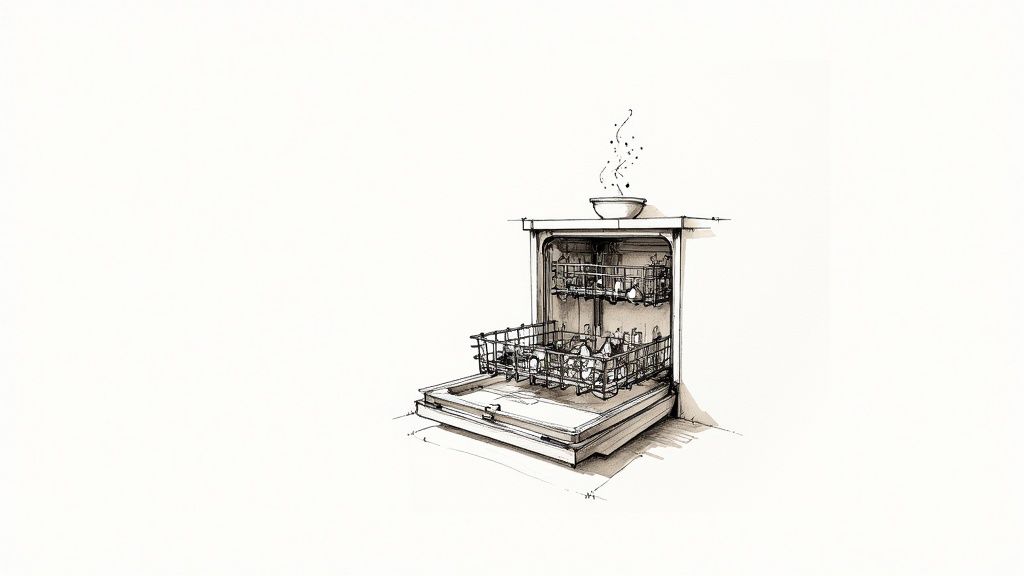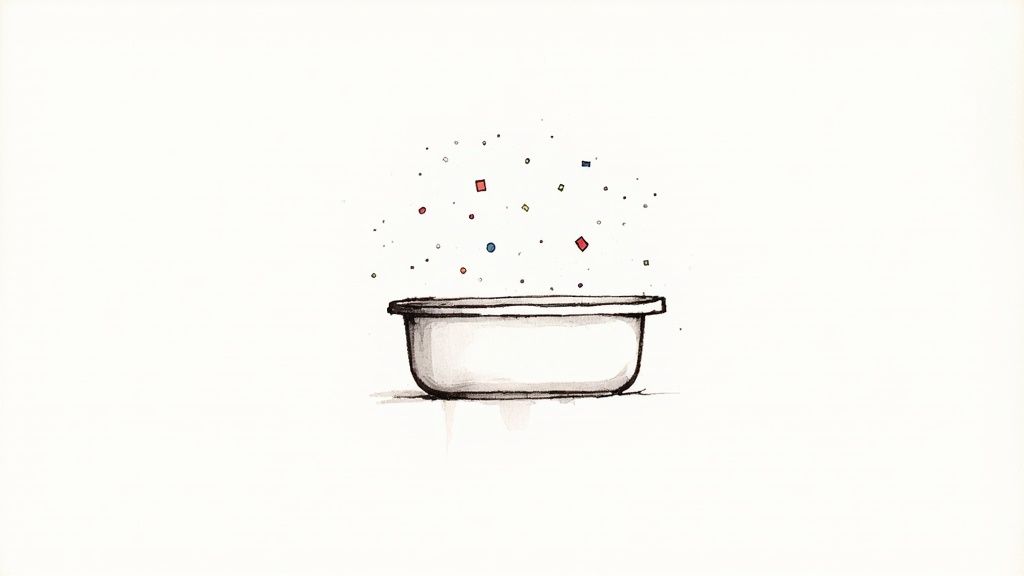If your glasses are coming out cloudy or a weird smell hits you when you open the door, it’s a sure sign your dishwasher needs a good cleaning. The fix is surprisingly simple: run a hot cycle with a cup of white vinegar on the top rack. After that, run another short, hot cycle with a cup of baking soda scattered across the bottom. This one-two punch is fantastic for safely breaking down all the gunk that’s killing your machine’s performance.
Why Your Dishwasher Isn't Cleaning Like It Used To

You'd think an appliance that cleans things for a living would stay clean itself, right? Unfortunately, that's not how it works. Over time, your dishwasher traps all the stuff it washes off your plates—grease, tiny bits of food, and hard water minerals. This grime builds up in places you can't easily see, like the filter, the spray arms, and even the hoses.
That residue doesn't just hang out. It starts causing real problems that are your first clue it's time for a deep clean.
The Signs of a Dirty Dishwasher
You’ll know your machine is crying out for help when you start noticing these classic issues:
- Cloudy Glassware: That white, filmy coating on your glasses? It's usually a dead giveaway of hard water mineral buildup.
- Persistent Odors: If you’re getting a sour, funky smell, it’s likely from old food particles that have gotten trapped and started to rot.
- Food Particles Left on Dishes: When the spray arms get clogged, water can't spray forcefully enough to rinse everything clean.
- Visible Grime: Sometimes you can see a slimy or gritty film building up along the bottom of the dishwasher or around the door seal.
This gunk is more than just gross; it physically blocks the water jets and can even become a breeding ground for mildew. To understand more about this, you can learn what happens if you eat mold in our detailed guide.
The real trick to this cleaning method is all about simple chemistry. The white vinegar is a mild acid, which makes it perfect for dissolving those tough mineral deposits and cutting through grease. Then, the baking soda comes in as a gentle abrasive to scrub away any loosened grime while also acting as a natural deodorizer to stamp out any leftover smells.
Instead of turning to harsh chemicals, these two pantry staples can get your dishwasher running like it’s brand new again.
Prepping Your Dishwasher for Its Deep Clean
Before you reach for the vinegar and baking soda, a little prep work goes a long way. If you want this deep clean to be truly effective, you need to deal with the obvious gunk first. This clears the path for the vinegar and baking soda to work their magic on the hidden grime inside the spray arms and drain.
First thing’s first: completely empty the dishwasher. Pull out the dishes, the utensil holder, and even the bottom rack. This gives you a clear, unobstructed view of the tub floor and the filter area.
Inspect and Clean the Filter
This is arguably the most important part of the entire process. Most modern dishwashers have a filter at the bottom of the tub—it usually looks like a cylinder that you can twist and pull out. This little part is almost always the main reason for bad smells and dishes that just aren't getting clean.
Once you have it out, take the filter over to your sink. If it has a separate mesh screen, pull that apart too. Give everything a good wash with hot, soapy water. I like to keep an old toothbrush under the sink just for this job; it's perfect for scrubbing away any stubborn food bits or greasy film without damaging the mesh.
Pro Tip: A clean filter is the single best thing you can do for your dishwasher's performance and longevity. Don't skip this step!
This handy visual breaks down the key prep steps.

As you can see, tackling the big, visible stuff first makes the rest of the cleaning process much more effective.
With the filter sparkling clean and back in its place, do one last sweep of the dishwasher's floor. Pick out any fallen noodles, stray plastic wrappers, or other random debris. Getting this stuff out now ensures it won't just get recirculated or, worse, clog your drain during the cleaning cycle.
Think of it like getting your ingredients ready before you start cooking—a little organization up front makes everything go smoother. Speaking of kitchen prep, we've put together some useful kitchen conversion tools to make your life even easier.
Time for the Vinegar Cycle: Sanitize and Descale

Alright, now that your dishwasher is empty and prepped, we're ready for the heavy lifting. This first cycle is where the magic really starts, using the natural power of vinegar to break down all that stubborn grime, soap scum, and mineral buildup.
Grab some plain white distilled vinegar and measure out one cup. Pour it into a dishwasher-safe bowl or even a glass measuring cup. A quick tip: don't pour the vinegar directly into the bottom of the dishwasher. Using a bowl lets it mix with the water slowly throughout the wash, which is far more effective.
Placing the Vinegar and Choosing the Right Cycle
Set the bowl of vinegar upright on the top rack. Just make sure it's stable and won't tip over once the water starts spraying.
Now, close the door and select the hottest, longest cycle your machine offers. This is usually called "Heavy," "Pots & Pans," or "Sanitize." The high heat is key here—it works with the vinegar to create a steamy, acidic environment that gets into every single corner, spray arm, and filter.
This vinegar bath is amazing at dissolving hard water deposits and cutting through the greasy film that can build up on the interior walls. It's a tried-and-true method recommended by professionals at places like MollyMaid.com for tackling tough residue before moving on to the final deodorizing step.
The secret is the vinegar's acidity. It's a natural descaler, safely breaking down that chalky white buildup that clogs your machine's parts and leaves your glasses looking cloudy.
When the cycle finishes and you open the door, you'll probably get a strong whiff of vinegar. Don't worry, that's totally normal and a sign that it worked! The smell will disappear completely as it airs out, leaving things much fresher than before.
While white vinegar is perfect for this job, if you're curious about other types, you can check out our guide on substitutes for white wine vinegar. Now, your dishwasher is perfectly prepped for the final step.
Using Baking Soda for the Final Polish and Deodorize

Now that the hot vinegar cycle has done the heavy lifting, it's time for the finishing touch. This next step is where we tackle any lingering grime and completely knock out those funky dishwasher odors for good.
Once the vinegar wash is finished, pop open the dishwasher and grab that bowl you placed on the top rack. Take one cup of baking soda and sprinkle it all over the bottom of the tub. Don't worry about getting it perfect—a generous dusting across the floor of the machine is all you need.
Running the Final Deodorizing Cycle
With the baking soda in, close the door and select another wash cycle. This time, a short, hot cycle is your best bet. The hot water will activate the baking soda, creating a gentle cleaning solution that gets into every nook and cranny.
Baking soda acts as a mild abrasive, so it's brilliant for scrubbing away any stubborn food bits or hard water stains the vinegar loosened up. But its real superpower here is deodorizing. It doesn't just cover up smells; it actually absorbs and neutralizes them, leaving your dishwasher smelling genuinely clean.
The secret to making this work is using vinegar and baking soda in separate cycles. If you mix them together, they basically cancel each other out, and you lose most of the cleaning power.
It's tempting to combine them for a one-and-done solution, but it’s crucial to understand why that doesn't work. The fizzing reaction you see when they mix is just them neutralizing each other, creating mostly salt water. By running them back-to-back, you get the full descaling force of the vinegar first, followed by the scrubbing and deodorizing punch of the baking soda.
The gentle but effective nature of baking soda makes it a kitchen MVP. In fact, that same scrubbing power is a lifesaver for other tough jobs, which you can see in our guide on how to clean your baking sheets.
Baking Soda vs Vinegar Cleaning Properties
To really get why this two-step process is so effective, it helps to see what each ingredient brings to the table. They play very different, yet complementary, roles in getting your dishwasher back to its best.
| Cleaning Agent | Primary Action | What It Removes | When to Use |
|---|---|---|---|
| Vinegar | Dissolves & Descales | Mineral deposits, hard water buildup, grease | First Cycle |
| Baking Soda | Scrubs & Deodorizes | Lingering food particles, stains, tough odors | Second Cycle |
By letting each one do its job independently, you’re hitting the problem from two different angles. Vinegar melts away the mineral scale, and baking soda follows up to scrub and freshen everything up.
Simple Habits to Keep Your Dishwasher Fresh
So, you’ve given your dishwasher a full refresh with baking soda and vinegar. The hard part is over! Now, keeping it clean is just a matter of weaving a few small habits into your routine. A little effort here and there goes a long way in preventing grime and bad smells from creeping back.
Think of that deep clean as a monthly reset. I find it helpful to set a quick reminder on my phone to run the vinegar and baking soda cycles every 30 days or so. This proactive approach stops buildup in its tracks before it ever becomes a real issue.
Weekly Upkeep for Peak Performance
Honestly, if you do just one thing, make it this: clean the filter. Seriously. Once a week, just pull it out and give it a good rinse under hot water. It takes less than 60 seconds, but it’s the number one cause of funky odors and dishes that don't get fully clean.
Another game-changer is scraping your plates before you load them. You don't need to pre-rinse them (that’s the dishwasher’s job!), but getting rid of big chunks of food keeps the filter and drain from getting clogged. It's a tiny step that can make a huge difference in how well your machine runs and how long it lasts.
Pro Tip: Before you hit "start," run the hot water at your kitchen sink until it gets hot. This ensures your dishwasher fills with hot water from the very beginning, which makes a surprisingly big difference in its cleaning power.
A Quick Word on Vinegar
It's worth mentioning that some manufacturers warn against using vinegar too often, suggesting it could wear down rubber seals over the long haul. The method we use—placing it in a bowl on the top rack—is incredibly safe and diluted. Still, it never hurts to peek at your appliance manual.
If you have an older dishwasher or just want to be extra cautious, you can always scale back your deep cleaning schedule to once every quarter. You'll still get all the descaling benefits you need. And while you're in the kitchen maintenance mindset, consider checking out our guide on how to season cast iron skillets for more useful tips.
Got Questions? Let's Talk Dishwasher Cleaning
Even with a simple process like this, some questions always come up. Getting these details right can make all the difference, helping you nail down a routine that keeps your dishwasher running perfectly. Let’s tackle some of the most common ones I hear.
How Often Should I Be Doing This?
For most families, running this baking soda and vinegar cycle once a month is the sweet spot. It's just enough to stop hard water scale and grimy buildup in its tracks before they become a real headache.
That said, you might need to adjust. If you live in an area with notoriously hard water, you’ll probably see those chalky spots on your glasses sooner. In that case, bumping up your deep clean to every three weeks can be a game-changer. On the flip side, if you have an older machine and you're worried about the vinegar being too harsh on the seals over time, stretching it out to every three months is a perfectly fine compromise.
The real secret is just being consistent. A little monthly maintenance goes a long way in preventing bigger problems down the road and keeps your machine cleaning like it should.
Can I Use Apple Cider Vinegar Instead?
I'd stick with white distilled vinegar for this one. While it's true that apple cider vinegar is acidic, it also contains sugars and a natural brown color. That can leave behind a slightly sticky film or even a faint stain inside your dishwasher.
Plain white vinegar does the job beautifully without any of those risks. It's cheap, clear, and made for this kind of cleaning.
What If It Still Smells After I've Cleaned It?
A lingering funky smell almost always points back to one thing: the filter. If that odor just won't quit, pull the filter out again for a second, more intensive scrub. Use a brush with some hot, soapy water and really get into all the nooks and crannies of the mesh screen.
If you're positive the filter is pristine and the smell is still there, you might have a clog starting in the drain hose. Another simple trick is to put a small, open bowl of baking soda on the top rack and just leave it in there overnight. It’s a great natural deodorizer and can absorb any stubborn smells that the cleaning cycles missed.

